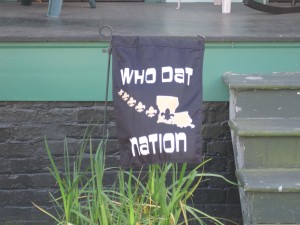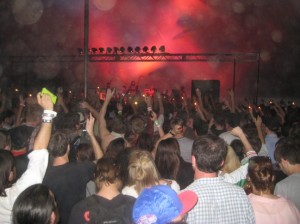Wow, it’s been a while. Struggling with my Big Freedia post. The one I haven’t written. I’ve narrated it to a few people and while it spooled out of my mouth no problem it doesn’t want to be written. Something that’s harder to put into blog space than to narrate to Alli Warren in a kitchen, something tangled up with race, gender, and New Orleans.
I’m thinking now, after some failed attempts, that I’ll have to spread this one out over several attempts and with some sketchy notes and please be patient with me.
My recent round of going nuts about Big Freedia began here, with the “Y’all Get Back Now” video:
Amazing in all kinds of ways. When I first watched the video I was captivated, among other things, by trying to figure out the role of whiteness. On the one hand, the video seemed to depict a utopian space where all of New Orleans – black to white, children to elders, women to men, neighborhood to neighborhood, even human to bulldog – can shake its asses together. Compelled to motion by the towering figure of Big Freedia on the skyline.
On the other hand, the video also started to seem like a narrative about the white creative class – in the video’s world, the guy in the office. And that narrative began to extend in my mind to the different ways bounce music has been received, in and out of New Orleans.
Though the video totally offers white people mixed into the Uptown and Downtown streetscapes, the emblematic figure for whiteness seems to be that office guy. (I think of him as a graphic designer – because of his hoody?)
He starts out glued to his computer. He’s in the one scene in the video that’s not iconographically New Orleans; he could be anywhere. Partying in the office space, not in the streets.
He’s really taken with the music. I assume that he’s receiving it the same way I am, over the computer. Though, in the video, he’s receiving it straight from the amused gaze of giant Big Freedia, a point that I hope to take up later.
I imagine that he’ll write a Big Freedia Pitchfork review after the video. But to refocus. What interests me particularly about his role in the video is its relationship to the reception of bounce music outside New Orleans.
I started reading extensively (well, Internet-extensively) about this after noticing a thread in an interview with Big Freedia, in which she insists, “Our music isn’t sissy bounce, we’re sissies who represent bounce music.”
To recap what she says about bounce in the interview, it’s the rap music of New Orleans, a call and response music based on the Triggerman beat. In the last ten years, Katey Red, Big Freedia, and Sissy Nobby have made huge contributions to that music and become the artists probably most recognized outside New Orleans.
(Though there have been ghost traces of bounce in huge mainstream successes such as “Back That Azz” up, i.e. compare to this old school bounce song, and as I mentioned in an earlier post Beyonce’s “Get Me Bodied” video.)
Anywayyy, at first I was confused by Big Freedia’s sentiment (“Our music isn’t sissy bounce”). I tend to feel a little disappointed or diminished when an author who’s a woman says “I’m not a woman writer, I’m just a writer.” I wondered if Big Freedia was saying basically that.
And I was confused particularly because it’s not like Katey Red, Big Freedia, and Sissy Nobby have been anything but celebratory of their queer identities.
But a number of readings and conversations made me see Big Freedia’s statement in another light. First, while reading Stephanie Young’s Jacket2 post “I hope for – everyone” it felt like nine lightbulbs were zinging on in my head. From her post:
“Ted {Rees} and I talked for a second about what it means when something radical and autonomous becomes visible, what happens when oppositional work, the squat garden or punk house flying under the radar, uncloaks. I’m thinking about the reasons one might want to uncloak (perhaps to make the idea that people can grow their own food more widely visible, more possible) but also the perils of doing so. Uncloaking. Often the uncloaking is outside of one’s control. Or money comes in like a black light, highlighting the abstract splotches of small un-glurped areas adjacent to the glurped parts. You’re adjacent, it can glurp you too.”
I started thinking about New Orleans and its intense localism. Of course it’s a huge tourist destination, and its peculiarities are articulated to and for the outside.
But that very performance of itself for tourists feels like the cloak, the under the radar. Keep the tourists in the French Quarter, while the locality of New Orleans is for living there. Tony marvels at the fact that when two New Orleans people meet, no matter how disparate in background, they always ask each other first thing, where did you go to high school? We all feel locatable.
(In interviews, I noticed that Big Freedia often mentions that she was choir director at her high school, Walter L. Cohen.)
The call and response nature of bounce is super-tied to the local – lists of wards, lists of high schools.
“I’m from Seventh Ward, you’re from 8th Ward, she’s from 9th Ward.”
I’m suddenly also thinking about something that could become a whole separate blog post: how New Orleans protects itself with a kind of intense local pride, that in the wake of Katrina has become intense internal marketing. Last time I was at home, Tony and I did a joke neighborhood photo-essay on Fleur-de-Lis imagery, Saints banners, etc., called “New Orleans is about itself.”
Anyway, anyway, anyway, where all this lead me in Big Freedia’s case was to her new non-local success.
And this, after ten intensely local years as the hardest working person in New Orleans show business. Doing two to three shows a day. Running an interior decorating company. As she said in another interview, she would decorate your party, then perform at your party.
And now she’s being interpreted through the national media, by white journalists, outside the context of the art form that she innovates in. This New York Times article I thought was good on the schism.
In that, it’s hard to make a question or an issue out of bounce music’s popularity in New Orleans. Bounce music is part of the neighborhood fabric.
And what makes “sissy bounce” (a journalist-invented term, I learned) popular or interesting outside New Orleans is partly that it’s seen as radical. Which, I mean, it is.
There’s a whole fascinating story about how Katey, Freedia, Nobby & others asserted a queer space in bounce music – Freedia talks about it in some interviews. And, there’s another whole fascinating story about how their music and presentation relates to ongoing genderfuck traditions in New Orleans.
And it’s awesome that Big Freedia is performing at Seattle’s Pride Week and in general it’s awesome that she’s become so successful, considering her genius. Because of the uncloaking, people from outside New Orleans and people like me, from outside her New Orleans, can learn about her art.
But there is still something hard to articulate, that seems linked to Big Freedia’s own hesitation around the term “sissy bounce”. And linked to the uncloaking and the glurping and the marketing.
Something around boundary crossing. About the desire to manifest, to be seen. About what then happens when a manifestation is refracted through – officialization? institutionalization? reification? Pushed into the bizarre marketing mirror-world.
On one level, there can be something patently exoticizing and tokenizing about the reception of bounce rap by these artists as a curiosity.
Some of the journalistic coverage doesn’t rise above the level of “Isn’t New Orleans fucked-up? They have openly gay rappers and drive-through dacquiri places!”

She's sure to turn heads when she wears this stylish Riot Grrrl Child's Halloween Costume. The Riot Grrrl costume includes the vinyl spike detailed dress and studded belt as shown. Add the Camo Girl boot tops as seen below and she'll be ready to riot in style.
Reading that style of journalism reminds me of the denouement of Girls to the Front, the amazing Sara Marcus book about the riot grrrl movement. Her story of the media feeding frenzy around riot grrrl and how that exposure/caricature wreaked havoc on riot grrrl participants is really depressing. Please see riot grrrl Halloween costume to the left.
Which gets me back to the part I keep circling around, which I think must be why it’s hard for me to write this post. Which is the part when race specifically comes in. And when the white person from New Orleans who’s writing the post thinks about herself as audience member.
The person writing the post wants to inhabit the white person’s fantasy of the “Y’all Get Back Now” video – to be received into this incredible party of collective New Orleans dancing. In which the role of the white creative class in the reception of an African-American form is gently twitted, but figured as basically benign.
Where if the person writing the post is lacking in dance skills, she could probably be dandled in arms like a baby or a bulldog. Cause Uptown’s gotta shake!
But naturally I know that, realistically, if I were to go to a Big Freedia performance – in the context I would go to one – I would not be a person in the “Y’all Get Back Now” video. I wouldn’t even be the hoody-wearer from the video, who I keep joke-criticizing as a stand-in for myself. I would be more like one of the members of this audience at Big Freedia’s SXSW performance:
Which maybe is OK. It’s not like I’m anything else at any other time, my utopian dreams aside. But it starts to seem problematic and difficult-to-write in a few ways.
One in that I have a point of contact with bounce music (the local; my hometown pride) that makes me feel more acutely my estrangement from its other points. I know I have to accept myself as a tourist in reference to this music. And that I have to feel some disgust with myself writing this post, as I take on an unearned explainer’s, expert’s, Expert Village tone. Doing my part in the uncloaking.
And then there’s the issue – which has come up so much for me around Claudia Rankine’s amazing intervention – of how to be a white person and write about race at all without being disgusting, in one of the so many ways to be disgusting. Like, being disgusting in being self-congratulatory for thinking about these important issues. Or like, much worse, being disgusting in, God help us all, becoming Baloney Hoagie.
And then there’s experimental poetry by white people, and writings on experimental poetry by white people – including myself here clearly – touching on hip-hop, and the tourisms there. I don’t even know what to say about that. Except, I’m confused.
And then finally, finally, finally – the most recent time we were in New Orleans, Tony and I went to the Backstreets Cultural Museum, an incredible institution in Treme that’s a repository of history for Mardi Gras Indian tribes and Social Aid and Pleasure Clubs.
The Social Aid and Pleasure Clubs put on second line parades. They come from African-American benevolent associations of the 1800s – mutual aid societies that took dues for funeral costs, community events, and so on. “Serving a purpose that today has largely been supplanted by insurance companies,” as the site I linked to proclaims with a very straight face.
Tony and I were talking to the head of the Backstreets Cultural Museum about how second line parades, traditionally more neighborhood affairs, were becoming more and more popular with white New Orleanians and with tourists.
We felt very conscious of our role in the scene as white New Orleanians (in my case) and as tourists (in my case and Tony’s).
The head of the Backstreets Cultural Museum talked about how, with second lines’ popularity, the New Orleans city government had begun requiring police presence at second lines and raising permit fees for parading clubs until they became unmanageable.
It was partly that pressure, the financial pressure, the head of the museum explained, that started the need to create institutions, like the Backstreets Cultural Museum, to preserve the culture that was being financially pressured.
Then the head of the museum asked us for a donation. In exchange for a donation of a certain, not very large amount, we could get emailed the private neighborhood parade routes of the Social Aid and Pleasure Clubs.
So the opening up of a culture to tourism led to government scrutiny. Which lead to the city: seizing the opportunity to make money? Police-protecting white people or tourists from themselves? Both? Which led to the culture having to further open itself up to tourism in order to preserve itself.
The head of the museum talked with what seemed like a mixture of pride and anger and politeness about the attention. The head of the museum talked about becoming an institution, having a board, writing grants.
I did make the donation. I get the emails, telling myself that since I don’t actually live in New Orleans, there’s no way I can further fuck things up for the Lady Jetsetters and the Ladies and Men of Unity, by showing up at their parade routes.
I think about how kind Big Freedia’s gaze is in the video as she peers into the office suite at her hyped-up white audience.
I also think about the part in the video where all the dancers are giants on the New Orleans skyline, with Big Freedia the most colossal of all. Trying to think something about the fantasy of being visible from afar, national – while also completely rooted in and representative of the local.
Lil Wayne at the end of Seat Down Low, “I am so, so New Orleans – like 1825 Tu…lane. See you gotta be from New Orleans to know what the fuck I’m talking about and if you’re not then fuck you, I say what I want.”



lauren,
To be brief–the thing about new orleans that you’ve missed altogether, is that it mostly doesn’t matter what color you are. Second Lines are open to everyone—the party is in the street. It gets all mixed up when the music is playing and booze is flowing and the mood raises everyone up. I don’t know where you are from, but perhaps a place that is more conscious of race? I wouldn’t think it to death—let your hair down and shake your ass if you want to.
Kevin Kline
Hey Kevin,
Thanks for your comment & for reading. I’m from New Orleans. Not that that means I can’t be wrong about New Orleans. And, I love the aspects of New Orleans you’re talking about. Public celebration & mixed-up-ness & shared culture. But, in my experience, New Orleans doesn’t seem less conscious of race than where I live now or other places I’ve lived. It seems like too much to go into in a comment box but I’d be interested to talk about it more if you want to write the magazine address at mrs.maybe@gmail.com –
Best, Lauren
From the looks of that video (which is brainsploding) Big Freedia has definitely read the latest Lindsey Boldt chap.
lauren, i so love how deeply u engage these subjects. u have an expansive mind and i love ur questioning. u are gracious, to boot. new orleans produced a fine daughter. one she is proud of, i’m sure.
on another note: i love big freedia. tried to see her last year when i was there, i’ve been going every year in the fall for the past several years, but this year ima make damn sure to. thank u for this complex portrait of bounce and this complication of locality. hot shit, mama.
xo